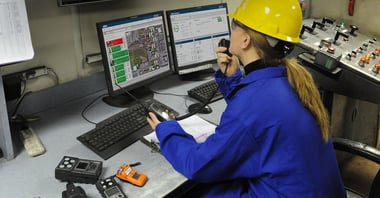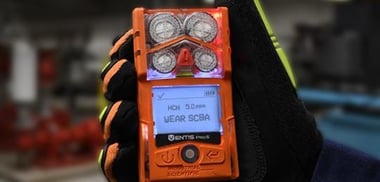Gas detection in the chemical industry can range from specialized meters in the hands of an Industrial Hygienist or Chemical Engineer to the everyday monitors used by operations personnel and hundreds of contractors at your site. Some workers may use a PID sensor to detect a specific gas like styrene or ethylene, while others could check for volatile organic compounds (VOCs) prior to a tank entry. During a shutdown or turnaround, contractors may use general four-gas monitors with a variety of other sensors added depending on what gas hazards could be present.
With such a wide range of chemical hazards that can be found throughout your plant, and so many different ways to detect them, it can be hard to keep track of who’s monitoring what gases, where, and how. The truth, however, is that keeping your employees safe has never been easier.
Most workers in a chemical plant can be fully protected against gas hazards with a small, personal gas monitor without a pump. However, just because most of your workers can rely on the same monitor with sensors tailored to the application, doesn’t mean your gas detection program is complete. Whether your gas monitoring program consists of a small team in one area or hundreds of contractors during a shutdown or turnaround, one point remains the same: visibility is critical.
With a standard gas monitor, you can only access gas alarm information after the user has left the field and docked the instrument. This leaves you in the dark about what hazards that worker was exposed to until they next dock the monitor, which could be in a day, a week, or even longer. Once the instrument is docked, you must then dig through historic data in your system to find out what safety issues your workers faced.
Or, you can equip your workers with connected safety tools that do the work for you.
New connected gas monitors, like the Ventis® Pro5 Multi-Gas Monitor, take reliable multi-gas monitoring to the next level by adding visibility into critical safety data. Wireless connectivity allows the monitor to instantly share gas readings, man-down alarms, panic alarms, and location data with safety managers and with peers nearby. With a variety of connectivity options to get your instrument data to the cloud, you can view all alarms in real time in a control room or anywhere in the world via text or email. The alerts contain all alarm and user information on a map with GPS coordinates, so you always know exactly when and where the incident occurred. With this information, you can follow up on safety issues in the moment, instead of days or even weeks later.
Protect the Perimeter
While individuals at your site are best protected when they’re connected to the cloud through Ventis Pro5 monitors, you can also connect area monitors for the same visibility into site conditions. An efficient way to do this is to set a perimeter around any work zone with Radius® BZ1 Area Monitors. When the area monitor detects a gas hazard, that alarm is shared with all connected personal and area monitors in the area, giving workers advance warning of changing site conditions. At the same time, the area monitor’s alarm also alerts safety contacts via text/email alerts.
Beyond protecting your workers on site, it’s important to consider the safety of communities around your chemical facility. During unplanned chemical releases, it’s critical for you to know what gas is being released and where it’s going, as well as whether nearby communities will be in danger. Plume modeling software can integrate real-time data from gas and weather sensors into advanced algorithms to help you decide what action you need to take.
In addition to real-time chemical emergency response, you can also use plume models to plan and prepare for future scenarios. For example, you can aggregate historical gas and weather data to explore “what if” a plant-wide power outage would require you to flare off product. Conducting exercises like this gives you the power to create an emergency response plan so you can be better prepared in case of an actual emergency.
PID: Cover a Range of VOCs
With your people and site covered, it’s time to focus on niche areas and applications within your plant. A specialized monitor with a PID sensor is useful for specific tasks where workers might encounter VOCs or other exotic gases, like checking a confined space for the initial entry and continuously monitoring the atmosphere throughout the job. These highly technical monitors offer advanced gas detection for sampling and permitting tasks.
When your workers clean a rail car after delivery or do hot work on a tank, many of the gas hazards that they could face do not have one specific sensor to detect them. This may initially sound like a major problem, but it’s one that you can easily solve with a PID sensor. Whether the hazard in question is a known gas or you are worried about general VOCs, a PID sensor will detect these if the gas in question has an ionization potential less than 10.6ev. For a broad range of coverage, your team can use the MX6 iBrid® with a PID sensor and still detect up to five other gasses simultaneously, giving you the convenience of one monitor for many uses, including confined space entries and any other gas sampling requirements.
In an industry as hazardous and complex as the chemical industry, it’s not enough to give workers a basic monitor and send them out to work. When it comes to your gas detection program, look for a comprehensive solution that gives both you and your workers visibility into gas hazards on site.



